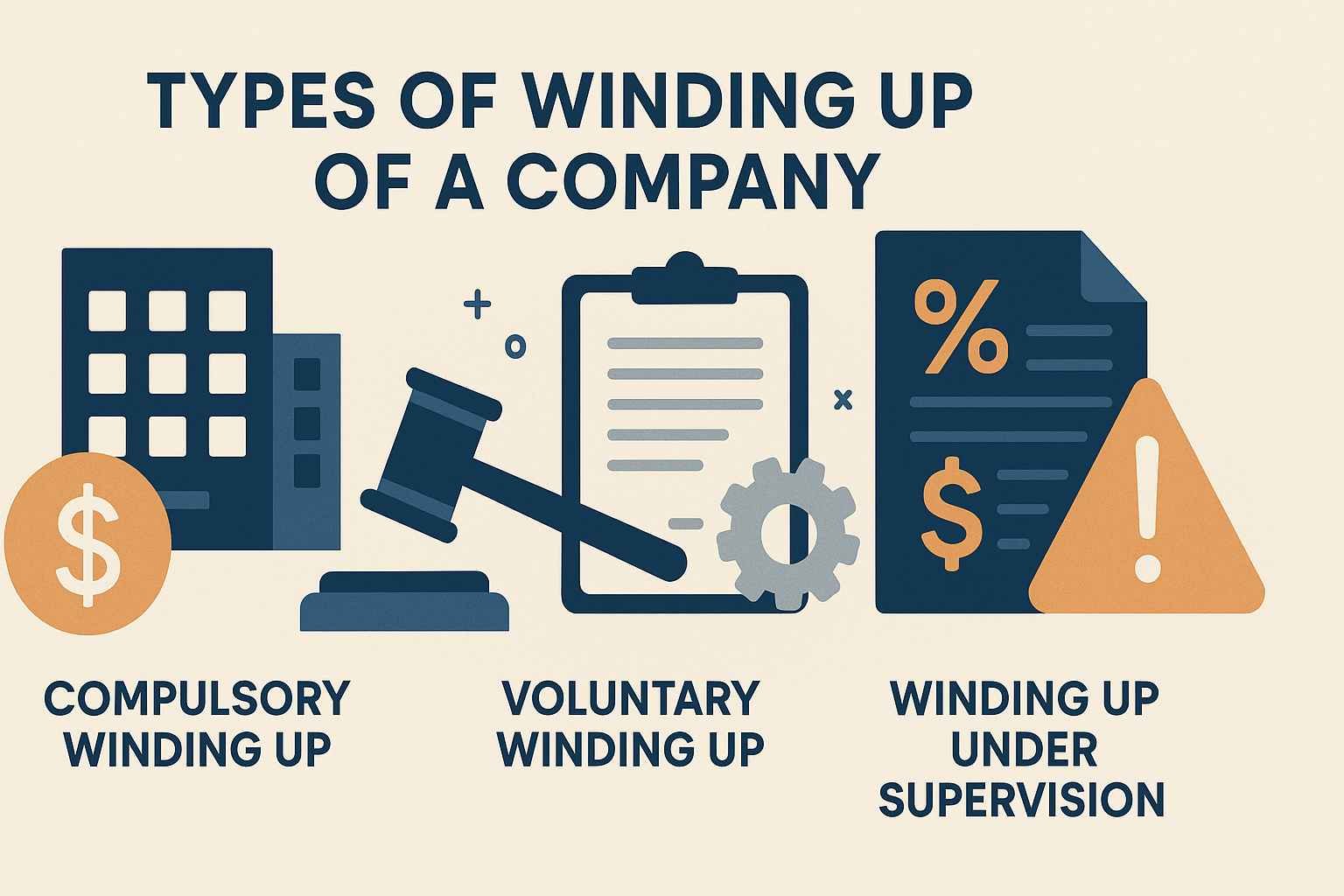On this page you will read detailed information about Types of Winding Up of a Company.
The journey of a company is not always about growth, expansion, and profits. At times, businesses reach a stage where they can no longer continue operations, either because of financial difficulties, legal requirements, or voluntary decisions by the owners. The process through which a company legally closes its affairs and distributes its assets to creditors and shareholders is known as winding up.
Winding up is not the same as striking off or dissolution. Striking off is an administrative act by the Registrar of Companies, while winding up involves a detailed legal process under the corporate laws of the country. This blog will explore the different types of winding up of a company, their procedures, and their implications for business owners, creditors, and stakeholders.
What is Winding Up?
In simple terms, winding up means bringing the life of a company to an end. Once the process starts, the company stops carrying on its business except for activities necessary for liquidation. A liquidator (an individual or an official appointed by the court or shareholders) takes control of the company’s assets, sells them, and ensures that the proceeds are used to repay debts. Whatever remains is distributed among shareholders.
The final outcome of winding up is the dissolution of the company, after which it ceases to exist as a legal entity.
Broad Categories of Winding Up
Company laws in most jurisdictions, including India under the Companies Act, 2013, recognize two primary types of winding up:
- Compulsory Winding Up by Tribunal (or Court)
- Voluntary Winding Up
In addition, certain laws also allow winding up under supervision of the court or hybrid models where voluntary decisions are combined with judicial oversight. Let us now look at these in detail.
1. Compulsory Winding Up
Compulsory winding up, also known as winding up by a tribunal or court, happens when an external authority orders the closure of the company. This usually takes place when the company violates legal provisions, becomes insolvent, or operates in a manner against public interest.
Grounds for Compulsory Winding Up
Some common grounds under which a tribunal may order winding up are:
- Inability to pay debts: If the company fails to clear its debts beyond a certain threshold, creditors can approach the tribunal for winding up.
- Unlawful or fraudulent acts: If the company engages in activities that are fraudulent, unlawful, or against the sovereignty and integrity of the country.
- Default in statutory obligations: Failure to file annual returns, financial statements, or other statutory documents may lead to winding up.
- Public interest: If the government or regulatory bodies believe that closing the company is necessary for public welfare.
- Special resolution: In some cases, if shareholders pass a special resolution requesting winding up, the tribunal may approve it.
Process of Compulsory Winding Up
- Filing a Petition – Creditors, contributories, the company itself, or government authorities can file a petition before the tribunal.
- Hearing by Tribunal – The tribunal examines whether the grounds for winding up are justified.
- Appointment of Liquidator – If the order is passed, a liquidator is appointed to take control of the company’s assets and liabilities.
- Realization of Assets & Settlement of Claims – The liquidator sells the assets, pays off creditors, and settles claims.
- Dissolution Order – Once the process is complete, the tribunal issues an order for dissolution, and the company ceases to exist.
Compulsory winding up is usually long, complex, and often associated with financial stress or legal violations.
2. Voluntary Winding Up
Voluntary winding up happens when the members or creditors of a company themselves decide to close the business. Unlike compulsory winding up, this process does not start with a court order but with internal resolutions.
Voluntary winding up can be of two types:
(a) Members’ Voluntary Winding Up
This occurs when the company is solvent, meaning it can pay all its debts in full. The decision is driven by shareholders or members who may feel that the company has outlived its purpose, achieved its objectives, or simply no longer wishes to operate.
Key Features:
- A declaration of solvency is made by the directors stating that the company can pay its debts within a specific period.
- Shareholders pass a special resolution to wind up the company.
- A liquidator is appointed by members to manage the process.
- Since the company is solvent, creditors are usually paid without disputes.
- The surplus, if any, is distributed among shareholders according to their shareholding.
This is generally considered a smooth and less controversial way of winding up.
(b) Creditors’ Voluntary Winding Up
This happens when the company is insolvent and unable to pay its debts. Unlike members’ voluntary winding up, here creditors play a central role in the process.
Key Features:
- Directors call a meeting of creditors and present a statement of the company’s financial position.
- Creditors appoint the liquidator, often overriding the choice made by members.
- The liquidator sells off assets and distributes proceeds among creditors as per priority.
- Secured creditors are paid first, followed by unsecured creditors, and if anything remains, it is distributed to shareholders.
This process is more complex because creditors’ interests dominate and disputes can arise regarding the valuation of assets or repayment priorities.
In the previous post, we had shared information about Understanding the Essentials of a Non Compete Agreement, so read that post also.
3. Winding Up Under the Supervision of Tribunal
This type of winding up acts as a bridge between voluntary and compulsory winding up. Here, a company may start voluntary winding up, but due to complaints from creditors or concerns about mismanagement, the tribunal may step in to supervise the process.
In such cases:
- The liquidator continues his role but under the oversight of the tribunal.
- The tribunal ensures that creditors and shareholders are treated fairly.
- This supervision is often ordered when the tribunal feels that voluntary winding up may not protect all stakeholders’ interests.
Although less common, this type ensures transparency and safeguards against misuse of voluntary closure provisions.
Consequences of Winding Up
Regardless of the type, winding up brings significant changes for all stakeholders involved:
- For the Company: It stops doing business except for liquidation activities. Legal identity ends after dissolution.
- For Directors & Management: They lose control over the company’s affairs, which shift to the liquidator.
- For Employees: Employment contracts are terminated, although outstanding dues must be cleared before dissolution.
- For Creditors: They get priority in repayment based on their category (secured, unsecured, preferential).
- For Shareholders: They receive whatever remains after creditors are fully paid.
Key Differences Between Compulsory and Voluntary Winding Up
| Aspect | Compulsory Winding Up | Voluntary Winding Up |
|---|---|---|
| Initiated By | Tribunal/Court | Members or Creditors |
| Reason | Legal violations, insolvency, public interest | Business decision, insolvency, or solvency |
| Control | Liquidator appointed by tribunal | Liquidator appointed by members/creditors |
| Nature | Often adversarial | Can be cooperative (in members’ case) |
| Speed | Generally slower, court-driven | Comparatively quicker |
Conclusion
Winding up of a company is not merely shutting down operations; it is a structured legal process that ensures fairness and accountability. Whether it is done compulsorily through a tribunal, voluntarily by members or creditors, or under judicial supervision, the ultimate goal is the same—settling obligations and lawfully dissolving the entity.
For business owners, understanding the types of winding up is crucial. If the company is solvent, a members’ voluntary winding up is the most efficient route. If debts overwhelm the business, creditors’ voluntary winding up or tribunal-led compulsory winding up may be inevitable.
In all cases, careful compliance with the law and transparent communication with stakeholders helps ensure a smooth closure.
Disclaimer
The information and services on this website are not intended to and shall not be used as legal advice. You should consult a Legal Professional for any legal or solicited advice. While we have good faith and our own independent research to every information listed on the website and do our best to ensure that the data provided is accurate. However, we do not guarantee the information provided is accurate and make no representation or warranty of any kind, express or implied, regarding the accuracy, adequacy, validity, reliability, availability, or completeness of any information on the Site. UNDER NO CIRCUMSTANCES SHALL WE HAVE ANY LIABILITY TO YOU FOR ANY LOSS OR DAMAGE OF ANY KIND INCURRED AS A RESULT OR RELIANCE ON ANY INFORMATION PROVIDED ON THE SITE. YOUR USE OF THE SITE AND YOUR RELIANCE ON ANY INFORMATION ON THE SITE IS SOLELY AT YOUR OWN RISK. Comments on this website are the sole responsibility of their writers so the accuracy, completeness, veracity, honesty, factuality and politeness of comments are not guaranteed.
So friends, today we talked about Types of Winding Up of a Company, hope you liked our post.
If you liked the information about Types of Winding Up of a Company, then definitely share this article with your friends.








